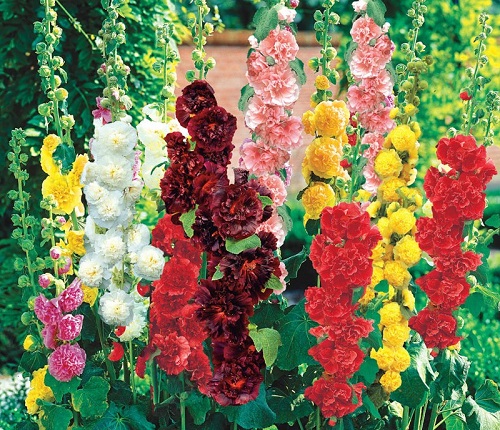
Hollyhock (Alcea rosea) is a beautiful flowering plant that is native to Asia and Europe. The plant was first introduced to North America in the 16th century by European settlers and quickly became popular as a garden plant.
The name “hollyhock” is thought to come from the Old English word “holy” (meaning “holy” or “sacred”) and the Middle English word “hok” (meaning “mallow”). This name reflects the plant’s historic use in herbal medicine, as it was believed to have medicinal properties and was used to treat a variety of ailments. Hollyhocks were also used as a source of dye for clothing and textiles.
The flowers can produce shades of pink, purple, red, and yellow, depending on the variety. In Victorian times, hollyhocks were a popular garden plant and were often featured in cottage gardens. The tall, stately stems and vibrant blooms made them a favorite among gardeners and landscape designers.
Today, hollyhocks are still popular garden plants, and are often used in cottage gardens, borders, and as a backdrop for other plants. They are also used in wildflower meadows and as a source of nectar for bees, butterflies, and other pollinators.
Hollyhocks are known for their tall, stately stems, which can reach up to 6 or 7 feet in height. The blooms are large and showy, with petals that are often ruffled or crinkled. The flowers can be single or double and are produced in a wide range of colors. Hollyhocks are typically grown as biennials, meaning they flower in their second year of growth.
How to Grow Hollyhocks
Sunny Location
Choose a sunny location: Hollyhocks prefer full sun to partial shade, so choose a spot in your garden that gets plenty of sunlight.
Well Drained Alkaline Soil
Hollyhocks prefer well-draining soil, so add compost or other organic matter to the soil to improve drainage and fertility. Hollyhocks also prefer slightly alkaline soil, with a pH of around 6.0 to 8.0.
Planting
Hollyhock seeds should be planted in the spring or fall. Sow the seeds directly into the soil, about 1/4 inch deep. Keep the soil moist until the seeds germinate, which can take up to two weeks.
Water Regularly
Hollyhocks prefer moist soil, so water them regularly to keep the soil evenly moist. Avoid overwatering, which can lead to root rot.
Provide Support
Hollyhocks can grow quite tall, so provide support for the stems with stakes or a trellis. This will help prevent the stems from bending or breaking.
Deadhead Regularly
To encourage continued blooming, deadhead the spent flowers regularly. This will also help prevent the plant from self-seeding and taking over the garden.
Watch for Pests and Diseases
Hollyhocks can be susceptible to aphids, spider mites, and rust fungus. Keep an eye out for these pests and diseases and treat them promptly if they occur.
10 Fun Facts About Hollyhocks
Hollyhock flowers were a popular garden plant in medieval times and were grown for their medicinal properties as well as their ornamental value.
In the language of flowers, hollyhocks represent fertility, ambition, and fruitfulness.
Hollyhocks are not just pretty flowers; they are also edible. The flowers can be used to make tea or added to salads for a pop of color.
Hollyhock flowers can grow to be quite tall – some varieties can reach up to 10 feet in height.
Hollyhock flowers come in a wide range of colors, from pink and purple to yellow and white.
In Victorian times, hollyhock flowers were often used as a symbol of nostalgia and remembrance.
Hollyhocks are a favorite food of the larvae of the painted lady butterfly.
Hollyhock flowers are sometimes called “moth mullions” because they are said to attract moths.
Hollyhock flowers are often used in herbal medicine to treat respiratory ailments and inflammation.
Hollyhock flowers have a long history of use in cosmetics – the petals can be used to create a natural dye or added to lotions and creams for their moisturizing properties.
Related Articles & Free Email Newsletter Sign Up
Flowering Maple is a Versatile Landscape or Houseplant
How to Grow and Propagate English Ivy
Impatiens are Easy to Grow and Add Vivid Color to Your Yard or Greenhouse




Comment here